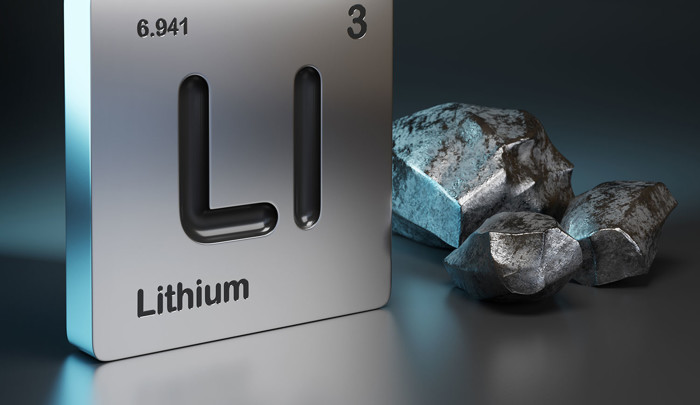What Is Lithium?
Learn more about lithium, "the white gold": Unveiling its origins, characteristics, and applications.
Introduction
Lithium, a versatile alkali metal, has captured global attention thanks to its remarkable properties and wide-ranging applications. From being the lightest metal to powering our electronic devices and electric vehicles, lithium's revolutionized multiple industries. In this blog post, we'll explore the origins of lithium, its various forms, extraction methods, environmental considerations, and its wide range of applications.
Table of contents:
Defining Lithium - A Light and Reactive Element
Lithium is a highly reactive alkali metal with the atomic number 3 and the symbol Li on the periodic table. It's a remarkable silvery-white to grey metal with distinct characteristics and properties. As the lightest metal, it has excellent electrochemical properties. Thanks to its low atomic weight and strong electronegativity, lithium can efficiently store and release electrical energy. Freshly exposed lithium has a metallic luster but quickly tarnishes when exposed to air, turning dull, silvery-grey, and eventually black.
Like other alkali metals - sodium, potassium, rubidium, and cesium - lithium is incredibly soft, even softer than talc on the Mohs scale. This softness means it can easily be cut with a knife. In its elemental form, lithium exhibits reactivity with water, although with less energy than other alkali metals, making it potentially explosive. It's also flammable in the presence of oxygen and can ignite when exposed to moist air. However, lithium doesn't occur naturally in its pure form; it exists in the wild as non-flammable compounds.
Lithium is a member of the alkali metal group known for its high reactivity. It tarnishes rapidly in air due to the formation of lithium oxide and lithium nitride. When exposed to pure oxygen, it burns with a bright red flame at 180°C, forming lithium oxide. It also reacts strongly with water, producing lithium hydroxide.

Different Forms of Lithium
Global lithium production involves several methods that yield different types of lithium compounds. Common variants include lithium carbonate, lithium hydroxide, lithium chloride, butyllithium, and lithium metal. These compounds are used across many industries, especially in battery production, including lithium-ion batteries that power portable electronics, electric vehicles, and renewable energy storage systems.
Lithium primarily exists in compound form in nature. The most common variants produced globally include:
Usage |
|
|---|---|
| Lithium carbonate | Widely used in lithium-ion batteries and pharmaceuticals. |
| Lithium hydroxide | Important for battery production, ceramics, and lubricants. |
| Lithium chloride | Utilized in air conditioning systems and as a catalyst in organic synthesis. |
| Butyllithium | An organolithium compound used in chemical reactions and as a polymerization initiator. |
| Lithium metal | Valuable for specialized applications, including lithium batteries and alloys. |
Usage
Lithium Deposits and Extraction Methods
Lithium deposits are found worldwide, with significant reserves in South America, Australia, and China. Let's examine the different types of lithium deposits and the extraction methods used for each.
It's important to note that the choice of extraction method depends on several factors, including the type of deposit, ore grade, economic viability, and environmental impact. Each method comes with its own set of advantages, challenges, and environmental considerations.
-
Lithium brine deposits
Lithium-rich brine deposits are a major source of lithium production, especially in South America. These deposits form over geologic time as lithium-rich brine accumulates in closed basins. The brine typically contains lithium salts dissolved in underground aquifers. While most extraction has focused on continental brine deposits, interest in geothermal and oilfield brines has grown significantly in recent years.
Extraction methods:
- Evaporation ponds: Brine is pumped into large evaporation ponds in areas with favorable climate conditions. Sunlight and natural evaporation gradually remove the water, leaving behind concentrated lithium salts. The remaining brine is then processed further to extract lithium compounds.
- Direct Lithium Extraction (DLE): This method pumps brine directly from underground aquifers and uses specialized technologies to selectively extract lithium. DLE techniques, such as selective ion exchange or adsorption, can significantly reduce the time and water needed for lithium extraction. Learn more about Direct Lithium Extraction technology.
-
Lithium hard rock deposits
Hard rock deposits, also known as pegmatite deposits, are another key source of lithium. These deposits contain lithium-rich minerals, such as spodumene, petalite, and lepidolite.
Extraction methods:
- Traditional mining: Hard rock lithium mining uses conventional mining techniques, such as drilling, blasting, and crushing, to extract ore containing lithium-bearing minerals. The ore is then processed through a combination of physical and chemical methods to produce lithium concentrates.
Environmental Implications
While lithium plays a crucial role in the clean energy transition, its extraction and production can have environmental consequences. Issues like water scarcity, habitat disruption, and chemical pollution need to be addressed through sustainable mining practices and responsible waste management. Efforts are also underway to develop battery recycling technologies,, which can help reduce the overall environmental impact of lithium use.

Lithium Applications
From advanced lithium-ion batteries to grid-stabilizing energy storage, lithium is transforming our renewable energy future.
This remarkable alkali metal has revolutionized energy storage - and much more. Its uses are vast, from powering smartphones and laptops to driving the rise of electric vehicles. But lithium's impact goes far beyond portable electronics. It's also essential in renewable energy storage systems, aerospace technologies, and even medical devices.
Join us as we explore lithium's diverse applications, including its benefits, environmental considerations, and pivotal role in shaping a more sustainable world.
-
Lithium-ion batteries
Lithium is widely used in rechargeable lithium-ion batteries.
Advantages:
- High energy density: Lithium-ion batteries offer a higher energy density than other battery technologies, delivering longer-lasting power and extended device runtime.
- Lightweight: Lithium's low atomic weight makes these batteries lightweight, which is ideal for portable electronics and electric vehicles.
- Fast charging: Lithium-ion batteries charge quickly, reducing wait times and improving convenience.
- Minimal memory effect: These batteries exhibit little to no memory effect, allowing for efficient charging and discharging cycles with minimal capacity loss.
From Batteries to Electric Vehicles: The Importance of Lithium Extraction
-
Electric vehicles (EVs)
Lithium-ion batteries are the go-to choice for electric vehicles.
Advantages:
- Extended driving range: These batteries deliver the energy density needed for EVs to travel longer distances between charges.
- Rapid acceleration: Lithium-ion batteries deliver high power output, enabling electric vehicles to achieve quick acceleration and strong performance.
- Environmentally friendly: EVs powered by lithium-ion batteries produce zero tailpipe emissions, helping cut air pollution and reduce greenhouse gas emissions.
-
Renewable energy storage
Lithium-ion batteries play a crucial role in storing energy generated from renewable sources, such as solar and wind.
Advantages:
- Smoothing energy supply: These batteries store excess energy during times of high production and release it when generation is low, helping to ensure a steady and reliable power supply.
- Grid stabilization: Lithium-ion energy storage systems help stabilize the grid by balancing fluctuations in supply and demand.
- Increased renewable integration: Battery storage makes it easier to integrate more solar and wind power into the grid, supporting the growth of clean, sustainable energy systems.
-
Portable electronics
Lithium-ion batteries are widely used in portable electronic devices, such as smartphones, laptops, tablets, and smartwatches.
Advantages:
- Compact and lightweight: These batteries pack high energy density into a small, lightweight form, perfect for portable electronics.
- Longer battery life: Their strong storage capacity means devices can run longer between charges, reducing the need for frequent recharging.
-
Aerospace and aviation
Lithium-based batteries are used in aerospace systems - including spacecraft, satellites, and aviation equipment.
Advantages:
- Weight reduction: Thanks to their lightweight nature, lithium-based batteries help reduce the overall weight of aerospace systems, which improves fuel efficiency and extends flight range.
-
Medical devices
Lithium-ion batteries are used in a range of medical devices, including pacemakers, defibrillators, and other implantable technologies.
Advantages:
- Long-lasting power: Their high energy density and extended battery life ensure reliable, continuous operation of medical devices over long periods.
-
Other applications
Lithium is also used in ceramics, glass, lubricants, greases, heat-resistant materials, and even pharmaceuticals.
Lithium - Essential for Energy Transition
Lithium, the lightest metal on Earth, is indispensable to the future of clean energy. Although it makes up just 0.002 percent of the Earth’s crust, lithium's unique properties make it essential for energy storage - the backbone of the global shift to renewables and electric vehicles.
Critical role in the energy transition
The move to clean energy technologies demands far more critical minerals than fossil-fuel-based systems, and lithium is right at the forefront. Energy storage is vital to this transition, and lithium's low weight, combined with its high energy density, makes it the ideal battery material. As the world phases out fossil fuels, demand for lithium is expected to continue rising, positioning it as a key player in the fight against climate change.
Securing a sustainable future with abundant resources
Governments worldwide have recognized lithium's strategic importance. The U.S. and Europe have classified it as a critical raw material essential to economic and technological stability. Fortunately, global lithium reserves are abundant, and with responsible and innovative extraction methods, they can meet the growing demand. That means lithium will remain a cornerstone of the green energy transition, helping to build a sustainable and resilient future for generations to come.
The race to secure lithium is also becoming a central issue in global geopolitics. The U.S. and the European Union are working to diversify their lithium sources and reduce their reliance on China, a move crucial to building independent, sustainable battery value chains. These efforts will be key to powering their green energy transitions and securing long-term energy and economic security.
Toward More Sustainable Lithium Mining
At Lithium Harvest, we're committed to a sustainable approach to lithium production - one that aligns with the principles outlined in this blog post. We recognize the growing demand for lithium and its essential role in advancing renewable energy and clean technologies. That's why our operations focus on environmentally responsible practices that minimize impact on ecosystems and local communities.
By using innovative extraction methods and smart water management strategies, we're working to reduce water usage and conserve this vital resource. Our goal is to meet the world's increasing demand for lithium while helping build a greener future. This blog post reflects our dedication to responsible lithium production and our belief that sustainability and progress can go hand in hand as we power a more energy-efficient world.

Lithium
You may also be interested in: